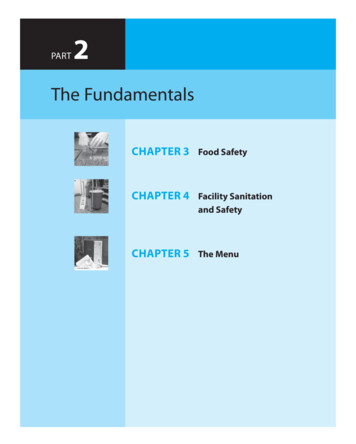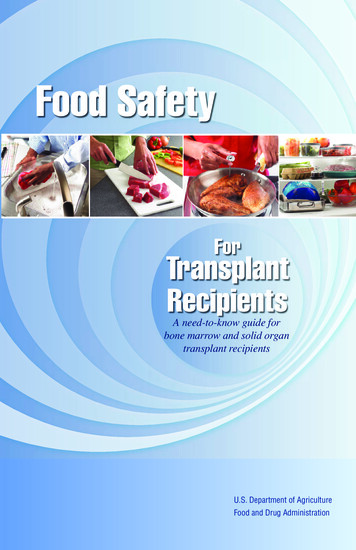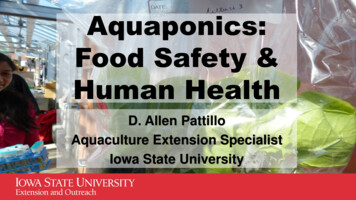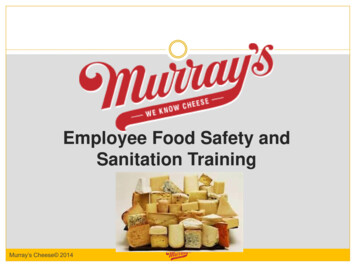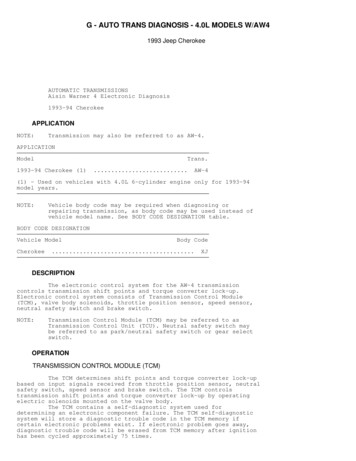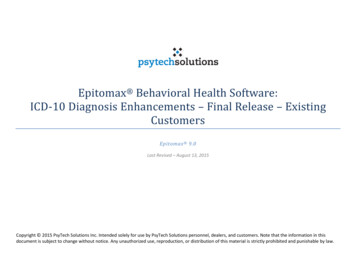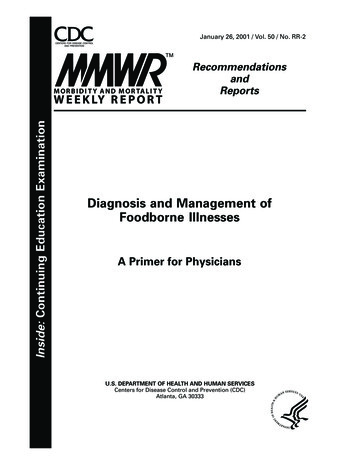
Transcription
Inside:ContinuingEducationExaminationInside: ContinuingContinuingMedicalEducationfor U.S.U.S.Physicians andand nuary 26, 2001 / Vol. 50 / No. RR-2RecommendationsandReportsDiagnosis and Management ofFoodborne IllnessesA Primer for PhysiciansU.S. DEPARTMENT OF HEALTH AND HUMAN SERVICESCenters for Disease Control and Prevention (CDC)Atlanta, GA 30333
The MMWR series of publications is published by the Epidemiology Program Office,Centers for Disease Control and Prevention (CDC), U.S. Department of Health andHuman Services, Atlanta, GA 30333.SUGGESTED CITATIONCenters for Disease Control and Prevention. Diagnosis and Management ofFoodborne Illnesses: a Primer for Physicians. MMWR 2001;50(No. RR-2):[inclusivepage numbers].Centers for Disease Control and Prevention . Jeffrey P. Koplan, M.D., M.P.H.DirectorThe material in this report was prepared for publication byNational Center for Infectious Diseases . James M. Hughes, M.D.DirectorDivision of Bacterial and Mycotic Diseases . Mitchell L. Cohen, M.D.DirectorDivision of Parasitic Diseases . Daniel G. Colley, Ph.D.DirectorDivision of Viral and Rickettsial Diseases . James W. LeDuc, Ph.D.Acting DirectorNational Center for Environmental Health . Richard J. Jackson, M.D., Dr.P.H.DirectorDivision of Emergency and EnvironmentalHealth Services . Patrick J. Meehan, M.D.DirectorThe production of this report as an MMWR serial publication was coordinated inEpidemiology Program Office . Stephen B. Thacker, M.D., M.Sc.DirectorOffice of Scientific and Health Communications . John W. Ward, M.D.DirectorEditor, MMWR SeriesRecommendations and Reports . Suzanne M. Hewitt, M.P.A.Managing Editor. Patricia A. McGeeProject Editor. Lynda CupellVisual Information Specialist. Michele D. RenshawErica R. ShaverInformation Technology Specialists
Vol. 50 / No. RR-2MMWRiNOTICEThis report is being reprinted with the permission of the American Medical Association;the Center for Food Safety and Nutrition, Food and Drug Administration; and the FoodSafety and Inspection Service, U.S. Department of Agriculture. It is reprinted as acourtesy to the MMWR readership.
iiMMWRJanuary 26, 2001PREFACEFoodborne illness is a serious public health problem. The Centers for Disease Control andPrevention (CDC) estimates that each year 76 million people get sick, more than 300,000 arehospitalized, and 5,000 Americans die as a result of foodborne illnesses, primarily the veryyoung, elderly, and the immunocompromised. Recent changes in human demographics andfood preferences, changes in food production and distribution systems, microbial adaptation, and lack of support for public health resources and infrastructure have led to the emergence of novel as well as traditional foodborne diseases. With increasing travel and tradeopportunities, it is not surprising that the risk of contracting and spreading a foodborneillness now exists locally, regionally, and even globally.Physicians have a critical role in the prevention and control of food-related disease outbreaks. This primer is intended to help physicians in this role by providing them with practicaland concise information on the diagnosis, treatment, and reporting of foodborne illnesses. Itwas developed collaboratively by the American Medical Association, the Centers for DiseaseControl and Prevention, the Food and Drug Administration’s Center for Food Safety andApplied Nutrition, and the US Department of Agriculture’s Food Safety and Inspection Serviceas part of President Clinton’s National Food Safety Initiative.We encourage you to review this information and participate in the attached continuingmedical education (CME) program. Even if you choose not to participate in the CME component, please take time to complete and return the “Program Evaluation Form.” Your feedbackis valuable for updating this primer and for planning future physician education programs.E. Ratcliffe Anderson, Jr., MDExecutive Vice President, CEOAmerican Medical AssociationJeffrey Koplan, MD, MPHDirectorCenters for Disease Control and PreventionJane E. Henney, MDCommissionerFood and Drug AdministrationThomas J. BillyAdministratorFood Safety and Inspection ServiceUS Department of Agriculture
Vol. 50 / No. RR-2MMWRiiiContentsPreface . iiWriters, Reviewers, Contributors . ivIntroduction . viBackground . 1Clinical Considerations . 2Foodborne Illness Charts . 11Infectious (bacterial, viral, parasitic) . 11Non-Infectious . 25Patient Scenarios . 29Botulism Poisoning . 29Escherichia coli O 157:H7 Infection . 35Enterotoxigenic Escherichia coli Infection . 41Listeria monocytogenes Infection . 45Clinical Vignettes: What’s Your Call? . 49Patient Information . 50Suggested Food Safety Resources and Reading List . 54Program Evaluation Form . 68Continuing Medical Education Activity . CE-1
ivMMWRJanuary 26, 2001Writers, Reviewers, ContributorsWRITING/WORKING GROUPAmerican Medical AssociationL J Tan, PhD (Working Group Chair)Jim Lyznicki, MS, MPHCenters for Disease Control and PreventionPenny M. Adcock, MDEileen Dunne, MD, MPHJulia Smith, MPHCenter for Food Safety and AppliedNutritionFood and Drug AdministrationEileen Parish, MDArthur Miller, PhDHoward SeltzerFood Safety and Inspection ServiceUS Department of AgricultureRuth Etzel, MD, PhDREVIEWERS/CONTRIBUTORSThe following organizations and individuals reviewed drafts of this document and providedvaluable comments:American Academy of Family PhysiciansAmerican Academy of PediatricsAmerican Association of Public HealthPhysiciansAmerican College of Emergency PhysiciansRoy Dehart, MDCenter for Occupationaland Environmental MedicineNashville, TNB. Clair Eliason, MDUniversity of IllinoisSchool of Medicine at RockfordRockford, ILAmerican College of Preventive MedicineAssociation of State and Territorial HealthOfficialsCouncil of State and TerritorialEpidemiologistsInfectious Diseases Society of AmericaPeter Chien, Jr.American Medical AssociationStudent SectionAd-Hoc Committee on Scientific IssuesChicago, ILMichael Crutcher, MD, MPHOklahoma State Department of HealthOklahoma City, OKJeffrey Davis, MD, MPHWisconsin Department of Healthand Family ServicesMadison, WIRichard Guerrant, MDHealth Sciences CenterUniversity of VirginiaCharlottesville, VABennett Lorber, MDTemple University School of MedicinePhiladelphia, PADale Morse, MDNew York State Department of HealthAlbany, NYMichael Moser, MD, MPHKansas Department of Healthand EnvironmentTopeka, KSMargaret Neill, MDMemorial Hospital of Rhode IslandPawtucket, RIMichael Osterholm, PhD, MPHican, Inc.Eden Prairie, MN
Vol. 50 / No. RR-2MMWRLouis Pickering, MDNational Immunization ProgramCenters for Disease Control and PreventionAtlanta, GAPhilip Tarr, MDChildren’s Hospital and RegionalMedical CenterUniversity of WashingtonSeattle, WAChristopher Shearer, MDPhoenix Baptist HospitalFamily Medicine CenterPhoenix, AZJames Walker, DVMOklahoma State Department of HealthOklahoma City, OKMelvyn Sterling, MD, FACPUniversity of CaliforniaIrvine, CAWilliam Weil, MDMichigan State UniversityEast Lansing, MIMade Sutjita, MD, PhDMorehouse School of MedicineAtlanta, GAv
viMMWRJanuary 26, 2001Diagnosis and Management of Foodborne Illnesses:A Primer for PhysiciansAmerican Medical AssociationCenters for Disease Control and PreventionCenter for Food Safety and Applied NutritionFood and Drug AdministrationFood Safety and Inspection ServiceUS Department of AgricultureThis activity has been planned and implemented in accordance with the Essential Areasand Policies of the Accreditation Council for Continuing Medical Education (ACCME) throughthe joint sponsorship of the Centers for Disease Control and Prevention (CDC), the Food Safetyand Inspection Services, US Department of Agriculture, and the Center for Food Safety andApplied Nutrition, Food and Drug Association. CDC is accredited by the ACCME to providecontinuing medical education for physicians.CDC designates this educational activity for a maximum of 3 hours in category 1 credittowards the AMA Physician’s Recognition Award. Each physician should claim only thosehours of credit that he/she actually spent in the educational activity.
Vol. 50 / No. RR-2MMWR1DIAGNOSIS AND MANAGEMENTOF FOODBORNE ILLNESSES:A PRIMER FOR PHYSICIANSBACKGROUNDThis primer is directed to primary care physicians, who are more likely to see theindex case of a potential food-related disease outbreak. It is a teaching tool to updateprimary care physicians about foodborne illness and remind them of their important rolein recognizing suspicious symptoms, disease clusters, and etiologic agents, and reporting cases of foodborne illness to public health authorities.Specifically, this guide urges physicians to: Recognize the potential for a foodborne etiology in a patient’s illness; Realize that many but not all cases of foodborne illness have gastrointestinal tractsymptoms; Obtain stool cultures in appropriate settings, and recognize that testing for somespecific pathogens, e.g. E. coli O157:H7, Vibrio spp., must be requested; Report suspect cases to appropriate public health officials; Talk with patients about ways to prevent food-related diseases; and Appreciate that any patient with foodborne illness may represent the sentinel caseof a more widespread outbreak.Foodborne illness is considered to be any illness that is related to food ingestion;gastrointestinal tract symptoms are the most common clinical manifestations offoodborne illnesses. This document provides detailed summary tables and charts, references, and resources for healthcare professionals. Patient scenarios and clinical vignettesare included for self-evaluation and to reinforce information presented in this primer.Also included is a CME component worth 3 credit hours.This primer is not a clinical guideline or definitive resource for the diagnosis andtreatment of foodborne illness. Safe food handling practices and technologies (e.g. irradiation, food processing and storage) also are not addressed. More detailed informationon these topics is available in the references and resources listed in this document, aswell as from medical specialists and medical specialty societies, state and local publichealth authorities, and federal government agencies.For additional copies, please contact:L J Tan, PhDAmerican Medical Association515 North State StreetChicago, Illinois 60610312 464-4147312 464-5841 (fax)litjen tan@ama-assn.org (E-mail)
2MMWRJanuary 26, 2001Or visit the following websites:The American Medical Associationhttp://www.ama-assn.org/foodborneThe Centers for Disease Control and Preventionhttp://www.cdc.govCenter for Food Safety and Applied Nutrition, Food and Drug Administrationhttp://www.fda.gov/cfsanFood Safety and Inspection Service, US Department of Agriculturehttp://www.usda.gov/fsisCLINICAL CONSIDERATIONSFood-related disease threats are numerous and varied, involving biological andnonbiological agents. Foodborne illnesses can be caused by microorganisms and theirtoxins, marine organisms and their toxins, fungi and their related toxins, and chemicalcontaminants. During the last 20 years, some foods that have been linked to outbreaksinclude: milk (Campylobacter ); shellfish (Norwalk-like viruses); unpasteurized apple cider (Escherichia coli O157:H7), eggs (Salmonella ); fish (ciguatera poisoning); raspberries (Cyclospora ); strawberries (hepatitis A virus); and ready-to-eat meats (Listeria ).While physicians have a critical role in surveillance for and prevention of potentialdisease outbreaks, only a fraction of the people who experience gastrointestinal tractsymptoms from foodborne illness seek medical care. In those who do seek care andsubmit specimens, bacteria are more likely than other pathogens to be identified ascausative agents. Bacterial agents most often identified in patients with foodborne illness in the United States are Campylobacter, Salmonella, and Shigella species, withsubstantial variation occurring by geographic area and season. Testing for viral etiologies of diarrheal disease is rarely done, but viruses are considered the most commoncause of foodborne illness.This section and the Foodborne Illnesses Tables summarize diagnostic features andlaboratory testing for bacterial, viral, parasitic, and noninfectious causes of foodborneillness. For more specific guidance, consult an appropriate medical specialist or medicalspecialty society, as well as various resources listed in other sections of this document.Also refer to this section and the Foodborne Illnesses Tables when working through thePatient Scenarios and Clinical Vignettes of this primer.RECOGNIZING FOODBORNE ILLNESSESPatients with foodborne illnesses typically present with gastrointestinal tract symptoms (e.g. vomiting, diarrhea, and abdominal pain); however, nonspecific symptoms andneurologic symptoms may also occur. Every outbreak begins with an index case whomay not be severely ill. A physician who encounters this person may be the only one withthe opportunity to make an early and expeditious diagnosis. Thus, the physician musthave a high index of suspicion and ask appropriate questions to recognize that an illnessmay have a foodborne etiology.Important clues to determining the etiology of a foodborne disease are the: Incubation period; Duration of the resultant illness;
Vol. 50 / No. RR-2MMWR3 Predominant clinical symptoms; and Population involved in the outbreak.Additional clues may be derived by asking whether the patient has consumed raw orpoorly cooked foods (e.g. raw or undercooked eggs, meats, shellfish, fish), unpasteurizedmilk or juices, home canned goods, fresh produce, or soft cheeses made from unpasteurized milk. Inquire whether any of the patient’s family members or close friends hassimilar symptoms. Inquiries about living on or visiting a farm, pet contact, day careattendance, occupation, foreign travel, travel to coastal areas, camping excursions tomountains or other areas where untreated water is consumed, and attendance at grouppicnics or similar outings also may provide clues for determining the etiology of theillness.If a foodborne illness is suspected, submit appropriate specimens for laboratory testing and contact the state or local health department for advice about epidemiologicinvestigation. For the physician, implication of a specific source in disease transmission isdifficult from a single patient encounter. Attempts to identify the source of the outbreakare best left to public health authorities.Because infectious diarrhea can be contagious and is easily spread, rapid and definitive identification of an etiologic agent may help control a disease outbreak. An individualphysician who obtains testing can contribute the necessary piece of data that ultimatelyleads to identification of the source of an outbreak.DIAGNOSING FOODBORNE ILLNESSESDifferential DiagnosisAs shown in Table 1 and the Foodborne Illnesses Tables a variety of infectious andnoninfectious agents must be considered in patients suspected of having a foodborneillness. Establishing a diagnosis can be difficult, however, particularly in patients withpersistent or chronic diarrhea, those with severe abdominal pain, and when there is anunderlying disease process. The extent of diagnostic evaluation depends on the clinicalpicture, the differential diagnosis considered, and clinical judgment.If any of the following signs and symptoms occur, alone or in combination, laboratorytesting may provide important diagnostic clues (particular attention should be given tovery young and elderly patients and to immunocompromised patients, all of whom aremore vulnerable): Bloody diarrhea Weight loss Diarrhea leading to dehydration Fever Prolonged diarrhea (3 or more unformed stools per day, persisting several days) Neurologic involvement such as paresthesias, motor weakness, cranial nervepalsies Sudden onset of nausea, vomiting, diarrhea Severe abdominal painIn addition to foodborne causes, a differential diagnosis of gastrointestinal tract disease should include underlying medical conditions such as irritable bowel syndrome;
4MMWRJanuary 26, 2001inflammatory bowel diseases such as Crohn’s disease or ulcerative colitis; malignancy;medication use (including antibiotic-related Clostridium difficile toxin colitis); gastrointestinal tract surgery or radiation; malabsorption syndromes; immune deficiencies; Brainerddiarrhea; and numerous other structural, functional, and metabolic etiologies. Consideration also should be given to exogenous factors such as the association of the illness withtravel, occupation, emotional stress, sexual practices, exposure to other ill persons,recent hospitalization, child care center attendance, and nursing home residence.The differential diagnosis of patients presenting with neurological symptoms due to afoodborne illness is also complex. Possible food-related causes to consider include recent ingestion of contaminated seafood, mushroom poisoning, and chemical poisoning.Because the ingestion of certain toxins (e.g. botulinum toxin, tetrodotoxin) and chemicals(e.g. organophosphates) can be life-threatening, a differential diagnosis must be madequickly with concern for aggressive therapy and life support measures (e.g. respiratorysupport, administration of antitoxin or atropine), and possible hospital admission.Clinical Microbiology TestingWhen submitting specimens for microbiologic testing, it is important to realize thatclinical microbiology laboratories differ in protocols used for the detection of pathogens.To optimize recovery of an etiologic agent, physicians should understand routine specimen collection and testing procedures as well as circumstances and procedures formaking special test requests. Some complex tests (e.g. toxin testing, serotyping, molecular techniques) may only be available from large commercial and public health laboratories. Contact your microbiology laboratory for more information.Stool cultures are indicated if the patient is immunocompromised, febrile, has bloodydiarrhea, has severe abdominal pain, or if the illness is clinically severe or persistent.Stool cultures are also indicated if many fecal leukocytes are present, which indicatesdiffuse colonic inflammation and is suggestive of invasive bacterial pathogens such asShigella, Salmonella, and Campylobacter species, and invasive E. coli. In most laboratories, routine stool cultures are limited to screening for Salmonella and Shigella species,and Campylobacter jejuni/coli. Cultures for Vibrio and Yersinia species, E. coli O157:H7,and Campylobacter species other than jejuni/coli require additional media or incubationconditions and therefore require advance notification or communication with laboratoryand infectious disease personnel.Stool examination for parasites generally is indicated for patients with suggestivetravel histories, who are immunocompromised, who suffer chronic or persistent diarrhea, or when the diarrheal illness is unresponsive to appropriate antimicrobial therapy.Stool examination for parasites is also indicated for gastrointestinal tract illnesses thatappear to have a long incubation period. Requests for ova and parasite examination of astool specimen will often enable identification of Giardia lamblia and Entamoebahistolytica, but a special request may be needed for detection of Cryptosporidiumparvum and Cyclospora cayetanensis. Each laboratory may vary in its routine procedures for detecting parasites so it is important to contact your laboratory.Blood cultures should be obtained when bacteremia or systemic infection are suspected.Direct antigen detection tests and molecular biology techniques are available forrapid identification of certain bacterial, viral, and parasitic agents in clinical specimens. Insome circumstances, microbiologic and chemical laboratory testing of vomitus or implicated food items also is warranted. For more information on laboratory procedures for
Vol. 50 / No. RR-2MMWR5Table 1. Etiologic Agents to Consider for Various Manifestations of Foodborne IllnessesClinical PresentationPotential Food-Related Agents to ConsiderGastroenteritis (vomitingas primary symptom;diarrhea also may bepresent)Viral gastroenteritis, most commonly rotavirus in an infant or Norwalk-likevirus in an older child or adult; or food poisoning due to preformed toxins (e.g.vomitoxin, Staphylococcus aureus toxin, Bacillus cereus toxin) and heavymetals.Noninflammatory diarrhea(acute watery diarrheawithout fever/dysentery;some cases may presentwith fever)*Can be caused by virtually all enteric pathogens (bacterial, viral, parasitic) butis a classic symptom of:Enterotoxigenic E. coliVibrio choleraeEnteric viruses (astroviruses, caliciviruses, enteric adenovirus, rotavirus)Cryptosporidium parvumCyclospora cayetanensisInflammatory diarrhea(invasive gastroenteritis;grossly bloody stool andfever may be present)†Shigella speciesCampylobacter speciesSalmonella speciesEnteroinvasive E. coliEnterohemorrhagic E. coliVibrio parahemolyticusEntamoeba histolyticaYersinia enterocoliticaPersistent diarrhea (lasting 14 days)Prolonged illness should prompt examination for parasites, particularly intravelers to mountainous or other areas where untreated water is consumed.Consider Cyclospora cayetanensis, Cryptosporidium parvum, Entamoebahistolytica, and Giardia lamblia.Neurologic manifestations(e.g. paresthesias,respiratory depression,bronchospasm)Botulism (Clostridium botulinum toxin)Organophosphate pesticidesThallium poisoningScombroid fish poisoning (histamine, saurine)Ciguatera fish poisoning (ciguatoxin)Tetrodon fish poisoning (tetrodotoxin)Neurotoxic shellfish poisoning (brevitoxin)Paralytic shellfish poisoning (saxitoxin)Amnesic shellfish poisoning (domoic acid)Mushroom poisoningGuillain-Barré Syndrome (associated with infectious diarrhea due to C. jejuni )Systemic illnessListeria monocytogenesBrucella speciesTrichinella spiralisToxoplasma gondiiVibrio vulnificusHepatitis A virus* Noninflammatory diarrhea is characterized by mucosal hypersecretion or decreased absorption without mucosaldestruction and generally involves the small intestine. Some affected patients may be dehydrated because ofsevere watery diarrhea and may appear seriously ill. This is more common in the young and the elderly. Mostpatients experience minimal dehydration and appear mildly ill with scant physical findings. Illness typicallyoccurs with abrupt onset and brief duration. Fever and systemic symptoms usually are absent (except forsymptoms related directly to intestinal fluid loss).†Inflammatory diarrhea is characterized by mucosal invasion with resulting inflammation and is caused byinvasive or cytotoxigenic microbial pathogens. The diarrheal illness usually involves the large intestine and maybe associated with fever, abdominal pain and tenderness, headache, nausea, vomiting, malaise, and myalgia.Stools may be bloody and may contain many fecal leukocytes.
6MMWRJanuary 26, 2001the detection of foodborne pathogens, consult an appropriate medical specialist, clinicalmicrobiologist, or state public health laboratory.TREATING FOODBORNE ILLNESSESSelection of appropriate treatment depends on identification of the responsible pathogen (if possible) and determining if specific therapy is available. Many episodes of acutegastroenteritis are self limiting and require fluid replacement and supportive care. Oralrehydration is indicated for patients who are mildly to moderately dehydrated; intravenous therapy may be required for more severe dehydration. Because many antidiarrheal agents have potentially serious adverse effects in infants and young children, theirroutine use is not recommended in this age group.Choice of antimicrobial therapy should be based on: Clinical signs and symptoms; Organism detected in clinical specimens; Antimicrobial susceptibility tests; and Appropriateness of treating with an antibiotic (some enteric bacterial infectionsare best not treated).Knowledge of the infectious agent and its antimicrobial susceptibility pattern allowsthe physician to initiate, change, or discontinue antimicrobial therapy. Such informationalso can support public health surveillance of infectious disease and antimicrobial resistance trends in the community. Antimicrobial resistance has increased for some entericpathogens, which requires judicious use of this therapy.SURVEILLANCE AND REPORTING OF FOODBORNE ILLNESSESReporting of foodborne illnesses in the United States began more than 50 years agowhen state health officers, concerned about the high morbidity and mortality caused bytyphoid fever and infantile diarrhea, recommended that cases of “enteric fever” beinvestigated and reported. The intent of investigating and reporting these cases was toobtain information about the role of food, milk, and water in outbreaks of gastrointestinaltract illness as the basis for public health actions. These early reporting efforts led to theenactment of important public health measures (e.g. the Pasteurized Milk Ordinance)that profoundly decreased the incidence of foodborne illnesses.Often health care professionals may suspect foodborne illness either because of theorganism involved or because of other available information, such as several ill patientswho have eaten the same food. Health care professionals can serve as the eyes and earsfor the health department by providing such information to the local or state public healthauthorities. Foodborne disease reporting is not only important for disease preventionand control, but more accurate assessments of the burden of foodborne illness in thecommunity occur when physicians report foodborne illnesses to the local or state healthdepartment. In addition, reporting of cases of foodborne illness by practicing physiciansto the local health department may help the health officer identify a foodborne diseaseoutbreak in the community. This may lead to early identification and removal of contaminated products from the commercial market. If a restaurant or other food service establishment is identified as the source of the outbreak, health officers will work to correctinadequate food preparation practices, if necessary. If the home is the likely source of thecontamination, health officers can institute public education about proper food handling
Vol. 50 / No. RR-2MMWR7practices. Occasionally, reporting may lead to the identification of a previously unrecognized agent of foodborne illness. Reporting also may lead to identification and appropriate management of human carriers of known foodborne pathogens, especially thosewith high-risk occupations for disease transmission such as foodworkers.Table 2 lists current reporting requirements for foodborne diseases and conditions inthe United States. National reporting requirements are determined collaboratively bythe Council of State and Territorial Epidemiologists and the Centers for Disease Controland Prevention (CDC).Typically, the appropriate procedure for physicians to follow in reporting foodborneillnesses is to contact the local or state health department whenever they identify aspecific notifiable disease. However, it is often unclear if a patient has a foodborne illnessprior to diagnostic tests, so physicians should also report potential foodborne illnesses,such as when two or more patients present with a similar illness that may have resultedfrom the ingestion of a common food. Local health departments then report the illnessesto the state health department and determine if further investigation is warranted.Each state health department reports foodborne illnesses to the CDC. The CDC compiles this data nationally and disseminates information to the public through annualsummary reports. The CDC assists state and local public health authorities with epidemiologic investigations and the design of interventions to prevent and controlfood-related outbreaks. The CDC also coordinates a national network of public healthlabo
illness now exists locally, regionally, and even globally. Physicians have a critical role in the prevention and control of food-related disease out-breaks. This primer is intended to help physicians in this role by providing them with practical and concise information on the diagnosis, treatment, and reporting of foodborne illnesses. It
